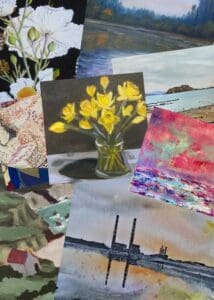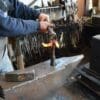Felt tip markers are a good medium to use for sketches as well as finished renderings for presentations, graphic design, advertising and package design. Felt tip markers are water or solvent based. Water based markers are generally non-toxic. Permanent markers are solvent based using xylene, ethyl alcohol, propyl alcohol or methyl isobutyl ketone as the vehicle. Avoid using xylene-containing permanent markers as they may cause dizziness, headaches and nausea. The vapors from methyl isobutyl ketone markers are also strongly irritating to many people. Permanent markers based on ethyl alcohol and propyl alcohol are much less toxic, even though the vapors may cause some minor eye or respiratory irritation. All markers should be used in areas with good ventilation.
Layout bond is a good paper to use with felt tip markers. Coated papers do not absorb the ink as well and a certain amount of color depth is lost. When using felt tip markers, the color does run a little on the paper. To control this, color a hair’s breadth inside your line, so that when the color bleeds, it is within the area that you want. Save your markers that run dry, they are excellent for feathering or filling in small spaces. When coloring an area black, many design students opt to use a charcoal gray color and then to come back with a black pencil to fill in any details such as lines or seams. Using charcoal gray does not lend itself to a rich looking black. I recommend using a black marker to color and then to come back with black gouache paint and a paintbrush and fill in details. The black gouache stands out very well over the black marker ink and the overall black looks very rich. This brings us to water- based paints.
Water-based paints include acrylic, watercolor, gouache, casein, and tempera. I will talk about watercolor and gouache paints, which are fairly similar. They consist mainly of a gum, water, preservatives and pigments. They may also contain glycerin, syrup and other nontoxic ingredients. Watercolor is more transparent especially when thinned with water, gouache contains chalky, calcium carbonate which makes it opaque. Both paint mediums are easy to clean up with water, fast drying and versatile.
The opacity of gouache makes it a very good medium to paint on colored papers. The pigments in these paints give rich and concentrated colors and can be mixed to give a vast spectrum. Pigments already mixed into paints are generally safe, as opposed to mixing your own pigment powder where they can be inhaled. The major hazard from pigments is accidentally ingesting the pigment. Some pigments that are toxic include compounds of cadmium, cobalt, lead, manganese and mercury. Chrome yellow, zinc yellow, strontium yellow and cadmium pigments are a few examples of pigments that may cause lung cancer. As a save guard do not eat or drink while using paints, wash hands afterward including under the finger nails.
Source by Rita Lee
Disclaimer: The views and opinions expressed in this article are those of the authors and do not necessarily reflect the official policy or position of Irish Artmart.




